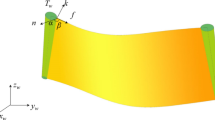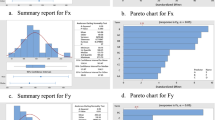Abstract
Recently, energy-efficient process planning has aroused numerous concerns from both industry and academia. However, as one of the most important tasks of process planning in discrete parts manufacturing system, tool selection has seldom been investigated in terms of energy efficiency. Without a good understanding of its effects on energy efficiency of machining process, energy-efficient manufacturing cannot be achieved to a satisfactory level. To bridge this research gap, this paper studies tool selection effects by analysing tools with different geometrical parameters, i.e. cutter radius, flute number and helix angle. Their effects on energy efficiency of slot milling process are analysed using experimental approach and theoretical approach, respectively. In experimental approach, Taguchi method is firstly applied to study the effects of each tool geometrical parameter. Then, analysis of variance (ANOVA) is performed to study the significance of each factor. In theoretical approach, the influence of tool selection on cutting power is analytically revealed. Subsequently, the energy efficiency of different cutters is quantitatively analysed through numerical experiments. The results are quite promising with both approaches leading to the same conclusion. The rank of influence is cutter radius > flute number > helix angle. Both methods suggest that a milling cutter with a larger cutter radius and fewer flutes will improve the energy efficiency in milling process. Although there is a small discrepancy in helix angle, it does not affect the good agreement of these two methods since the influence of the helix angle is nearly negligible. Compared to experimental approach, theoretical approach may have more application potential since it may help reduce time and waste of materials. To the best knowledge of the authors, the effects of tool selection on energy efficiency in milling process are systematically analysed for the first time, which significantly advances the state of the art in energy-efficient process planning.




Similar content being viewed by others
References
Liu N, Zhang YF, Lu WF (2019) Improving energy efficiency in discrete parts manufacturing system using an ultra-flexible job shop scheduling algorithm. Int J Precis Eng Manuf Technol 6:349–365. https://doi.org/10.1007/s40684-019-00055-y
Mori M, Fujishima M, Inamasu Y, Oda Y (2011) A study on energy efficiency improvement for machine tools. CIRP Ann - Manuf Technol 60:145–148. https://doi.org/10.1016/j.cirp.2011.03.099
He Y, Liu F, Wu T, Zhong FP, Peng B (2012) Analysis and estimation of energy consumption for numerical control machining. Proc Inst Mech Eng Part B J Eng Manuf 226:255–266. https://doi.org/10.1177/0954405411417673
Altıntaş RS, Kahya M, Ünver HÖ (2016) Modelling and optimization of energy consumption for feature based milling. Int J Adv Manuf Technol 86:3345–3363. https://doi.org/10.1007/s00170-016-8441-7
Wang Z (2017) Optimization calculation of reverse energy consumption based on feature parameter of NC code. Int J Adv Manuf Technol 93:3437–3448. https://doi.org/10.1007/s00170-017-0746-7
Chen X, Li C, Jin Y, Li L (2018) Optimization of cutting parameters with a sustainable consideration of electrical energy and embodied energy of materials. Int J Adv Manuf Technol 96:775–788. https://doi.org/10.1007/s00170-018-1647-0
Gutowski T, Dahmus J, Thiriez A (2006) Electrical energy requirements for manufacturing processes. In: 13th CIRP Int Conf life cycle Eng, LCE 2006, pp 623–627
Li W, Kara S (2011) An empirical model for predicting energy consumption of manufacturing processes: a case of turning process. Proc Inst Mech Eng Part B J Eng Manuf 225:1636–1646. https://doi.org/10.1177/2041297511398541
Nancy D, David D (2011) Energy consumption characterization and reduction strategies for milling machine tool use. In: 18th CIRP International Conference on Life Cycle Engineering, LCE 2011, pp 263–267
Kara S, Li W (2011) Unit process energy consumption models for material removal processes. CIRP Ann - Manuf Technol 60:37–40. https://doi.org/10.1016/j.cirp.2011.03.018
Li W, Winter M, Kara S, Herrmann C (2012) Eco-efficiency of manufacturing processes: a grinding case. CIRP Ann - Manuf Technol 61:59–62. https://doi.org/10.1016/j.cirp.2012.03.029
Li L, Yan J, Xing Z (2013) Energy requirements evaluation of milling machines based on thermal equilibrium and empirical modelling. J Clean Prod 52:113–121. https://doi.org/10.1016/j.jclepro.2013.02.039
Liu N, Zhang YF, Lu WF (2015) A hybrid approach to energy consumption modelling based on cutting power: a milling case. J Clean Prod 104:264–272. https://doi.org/10.1016/j.jclepro.2015.05.049
Shi KN, Zhang DH, Liu N, Wang SB, Ren JX, Wang SL (2018) A novel energy consumption model for milling process considering tool wear progression. J Clean Prod 184:152–159. https://doi.org/10.1016/j.jclepro.2018.02.239
Hanafi I, Khamlichi A, Cabrera FM, Almansa E, Jabbouri A (2012) Optimization of cutting conditions for sustainable machining of PEEK-CF30 using TiN tools. J Clean Prod 33:1–9. https://doi.org/10.1016/j.jclepro.2012.05.005
Camposeco-Negrete C (2013) Optimization of cutting parameters for minimizing energy consumption in turning of AISI 6061 T6 using Taguchi methodology and ANOVA. J Clean Prod 53:195–203. https://doi.org/10.1016/j.jclepro.2013.03.049
Bhushan RK (2013) Optimization of cutting parameters for minimizing power consumption and maximizing tool life during machining of Al alloy SiC particle composites. J Clean Prod 39:242–254. https://doi.org/10.1016/j.jclepro.2012.08.008
Campatelli G, Lorenzini L, Scippa A (2014) Optimization of process parameters using a response surface method for minimizing power consumption in the milling of carbon steel. J Clean Prod 66:309–316. https://doi.org/10.1016/j.jclepro.2013.10.025
Zhang Y, Zou P, Li B, Liang S (2015) Study on optimized principles of process parameters for environmentally friendly machining austenitic stainless steel with high efficiency and little energy consumption. Int J Adv Manuf Technol 79:89–99. https://doi.org/10.1007/s00170-014-6763-x
Camposeco-Negrete C, Nájera J de DC, Miranda-Valenzuela JC (2016) Optimization of cutting parameters to minimize energy consumption during turning of AISI 1018 steel at constant material removal rate using robust design. Int J Adv Manuf Technol 83(5–8):1341–1347. https://doi.org/10.1007/s00170-015-7679-9
Li C, Xiao Q, Tang Y, Li L (2016) A method integrating Taguchi, RSM and MOPSO to CNC machining parameters optimization for energy saving. J Clean Prod 135:263–275. https://doi.org/10.1016/j.jclepro.2016.06.097
Ma F, Zhang H, Cao H, Hon KKB (2017) An energy consumption optimization strategy for CNC milling. Int J Adv Manuf Technol 90:1715–1726. https://doi.org/10.1007/s00170-016-9497-0
Shin SJ, Woo J, Rachuri S (2017) Energy efficiency of milling machining: component modeling and online optimization of cutting parameters. J Clean Prod 161:12–29. https://doi.org/10.1016/j.jclepro.2017.05.013
Li C, Chen X, Tang Y, Li L (2017) Selection of optimum parameters in multi-pass face milling for maximum energy efficiency and minimum production cost. J Clean Prod 140:1805–1818. https://doi.org/10.1016/j.jclepro.2016.07.086
Warsi SS, Jaffery SHI, Ahmad Khan RM, Agha MH, Ali L (2018) Development and analysis of energy consumption map for high-speed machining of Al 6061-T6 alloy. Int J Adv Manuf Technol 96:91–102. https://doi.org/10.1007/s00170-018-1588-7
Li B, Cao H, Yan J, Jafar S (2017) A life cycle approach to characterizing carbon efficiency of cutting tools. Int J Adv Manuf Technol 93:3347–3355. https://doi.org/10.1007/s00170-017-0728-9
Wang YC, Kim DW, Katayama H, Hsueh WC (2018) Optimization of machining economics and energy consumption in face milling operations. Int J Adv Manuf Technol 99:1–8. https://doi.org/10.1007/s00170-018-1848-6
Ma GH, Zhang YF, Nee a YC (2000) A simulated annealing-based optimization algorithm for process planning. Int J Prod Res 38:2671–2687. https://doi.org/10.1080/002075400411420
Ozturk E, Ozkirimli O, Gibbons T, Saibi M, Turner S (2016) Prediction of effect of helix angle on cutting force coefficients for design of new tools. CIRP Ann - Manuf Technol 65:125–128. https://doi.org/10.1016/j.cirp.2016.04.042
Funding
This study was supported by the National Natural Science Foundation of China (Grant No. 51775444 and Grant No. 41601117). The authors would like to acknowledge this financial support.
Author information
Authors and Affiliations
Corresponding author
Additional information
Publisher’s note
Springer Nature remains neutral with regard to jurisdictional claims in published maps and institutional affiliations.
Rights and permissions
About this article
Cite this article
Shi, K.N., Liu, N., Wang, S.B. et al. Experimental and theoretical investigation of milling tool selection towards energy-efficient process planning in discrete parts manufacturing. Int J Adv Manuf Technol 104, 1099–1107 (2019). https://doi.org/10.1007/s00170-019-03960-3
Received:
Accepted:
Published:
Issue Date:
DOI: https://doi.org/10.1007/s00170-019-03960-3




